
Pasiphila bilineolata is a moth in the family Geometridae. It is endemic to New Zealand and can be found in the North and South Islands. The species inhabits native forest and shrubland and the larvae feed on Hebe species. Adults are on the wing commonly from August to January but have been observed most months of the year and are attracted to light.

Epiphryne undosata, also known as the lacebark looper, is a moth of the family Geometridae. It is endemic to New Zealand and is found on both the North and South Islands. It inhabits native forest. The larvae feed on plant species in the genera Hoheria and Plagianthus. They pupate amongst dead leaves in a silk cocoon. The adult moths have been observed on the wing all year round but are most commonly seen from November until February. The adult moths are extremely variable in both their colour intensity and wing pattern.
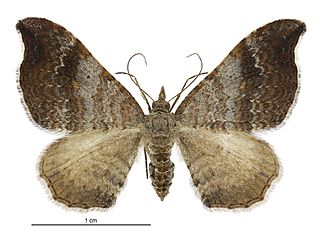
Homodotis megaspilata, also known as the small hooked-tip looper moth, is a moth of the family Geometridae. It is endemic to New Zealand and can be found throughout the country. It is regarded as being common species. The preferred habitat of this species is native forest, scrub, coastal areas and domestic gardens. Larvae feed on the dead leaves of Geniostoma ligustrifolium and likely other native plants. Once mature the larvae will pupate on the ground forming a silken cocoon protected by hiding inside two leaves of its host plant. Adults are nocturnal and are on the wing from October to April. They are attracted to light. In appearance the adults of this species are extremely variable but can be distinguished from similar species as all variations have forewings with blunt hook shaped tips.

Eudonia sabulosella is a species of moth in the family Crambidae. This species is endemic to New Zealand and is regarded as being common. The larvae of this species are known to damage pasture in New Zealand.
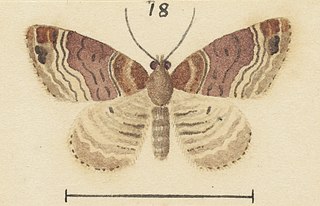
Hydriomena iolanthe is a species of moth in the family Geometridae. It is indigenous to New Zealand. This species is based on a single specimen that is now lost and has not been matched to any known species. As such it is classified as data deficient by the Department of Conservation.

Asaphodes clarata is a species of moth in the family Geometridae. This species is endemic to New Zealand and has been found on the North and South Islands. The species inhabits open grassy areas, including tussock grasslands, in montane habitat. The larvae feed on the leaves of Ranunculus species. The adult moths are day flying and are on the wing from December to February and have been shown to pollinate Celmisia laricifolia and Hebe pinguifolia.
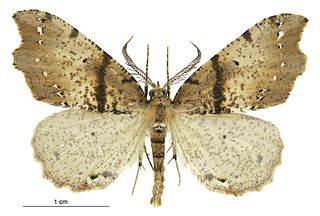
Chalastra pellurgata, also known as the brown fern moth or the pale fern looper, is a moth of the family Geometridae. This species was first described by Francis Walker in 1862. It is endemic to New Zealand and can be found throughout the country. It inhabits native forest. This species is extremely variable both in its larval and adult life stage. Larvae of this species are active during spring and summer. They feed on the fronds of fern species. C. pellurgata pupates by forming a thin cocoon on the soil amongst leaf litter and moss. Adults are on the wing throughout the year but are most common from September to March. During the day adult moths can be observed resting on dead fern fronds. They become active from dusk and are attracted to light.

Ichneutica disjungens is a moth of the family Noctuidae. This species is endemic to New Zealand and can be found on the central volcanic plateau of the North Island and in the eastern as well as the south western parts of the South Island. I. disjungens inhabits tussock grasslands in the alpine and subalpine zones. The hosts of the larvae of this species include Poa cita, P. colensoi, and Festuca novae-zelandiae. The adults of this species are distinctive and are unlikely to be confused with other species. They are on the wing between October and March.
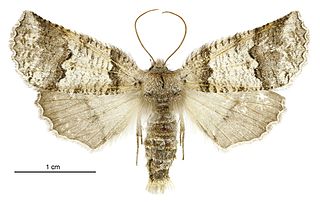
Declana feredayi is a species of moth in the family Geometridae. It is endemic to New Zealand. Adults of this species pollinate Hoheria Iyallii.
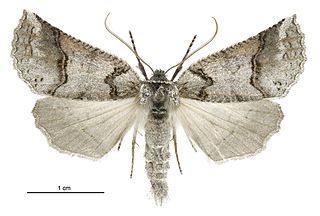
Declana junctilinea is a species of moth in the family Geometridae. It is endemic to New Zealand. Adults of this species pollinate Dracophyllum acerosum and Leptospermum scoparium.

Epiphryne xanthaspis, also known as the Aristotelia Looper, is a moth in the family Geometridae. This species was first described by Edward Meyrick in 1883. It is endemic to New Zealand and can be found from the central North Island southward to the bottom of the South Island. The preferred habitat of this species is sub-alpine native forest. The larval hosts of E. xanthaspis are plants in the genus Aristotelia and include Aristotelia fruticosa. Adults are on the wing from December until March.

Helastia semisignata is a moth of the family Geometridae. This species is endemic to New Zealand and is only found in the North Island. The life history of this species is in need of further investigation as sources differ about what plants host the larvae. Adults are on the wing commonly from October until March.
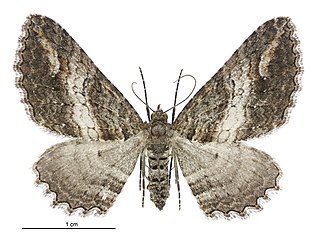
Horisme suppressaria is a moth of the family Geometridae. This species was first described by Francis Walker. Currently the taxonomy of this species is uncertain and as a result this species is also known as Horisme (s.l.) suppressaria. The species is endemic to New Zealand and has been observed in both the North and South Islands. The larval hosts of H. suppressaria are species in the genus Corokia including Corokia cotoneaster.
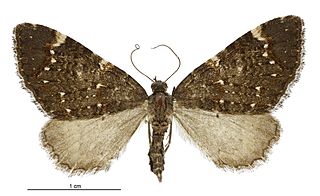
Hydriomena arida is a species of moth in the family Geometridae. This species is endemic to New Zealand. It has been hypothesised that species belongs to another genus and so this species is also currently known as Hydriomena (s.l.) arida.

Hydriomena canescens is a species of moth in the family Geometridae. It was first described by Alfred Philpott in 1918. This species is endemic to New Zealand. The classification of New Zealand endemic moths within the genus Hydriomena is regarded as unsatisfactory and in need of revision. As such this species is currently also known as Hydriomena (s.l.) canescens.
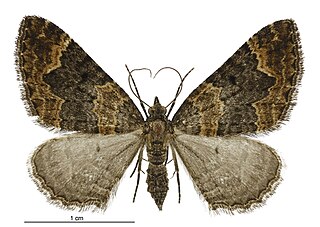
Hydriomena hemizona is a species of moth in the family Geometridae. It was first described by Edward Meyrick in 1897. This species is endemic to New Zealand. The classification of New Zealand endemic moths within the genus Hydriomena is regarded as unsatisfactory and in need of revision. As such this species is currently also known as Hydriomena (s.l.) hemizona.
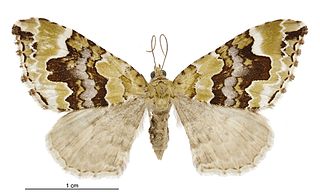
Hydriomena purpurifera is a species of moth in the family Geometridae. It was first described by Richard William Fereday in 1883. This species is endemic to New Zealand. The classification of New Zealand endemic moths within the genus Hydriomena is regarded as unsatisfactory and in need of revision. As such this species is currently also known as Hydriomena (s.l.) purpurifera.
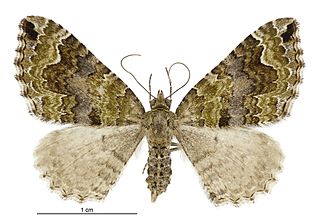
Hydriomena rixata is a species of moth in the family Geometridae. It was first described in 1875. This species is endemic to New Zealand. The classification of New Zealand endemic moths within the genus Hydriomena is regarded as unsatisfactory and in need of revision. As such this species is currently also known as Hydriomena (s.l.) rixata. The adults of this moth are known to pollinate Dracophyllum acerosum.
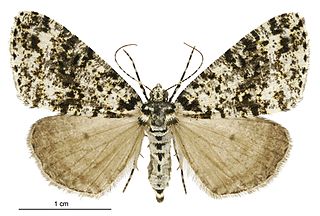
Pseudocoremia monacha is a species of moth in the family Geometridae. It is endemic to New Zealand. Adults of this species pollinate Veronica salicifolia.
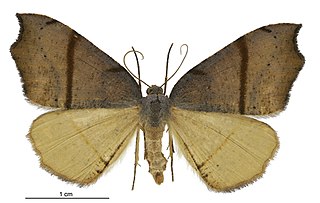
Sestra flexata, also known as the common fern looper, is a species of moth in the family Geometridae. This species is endemic to New Zealand.





















